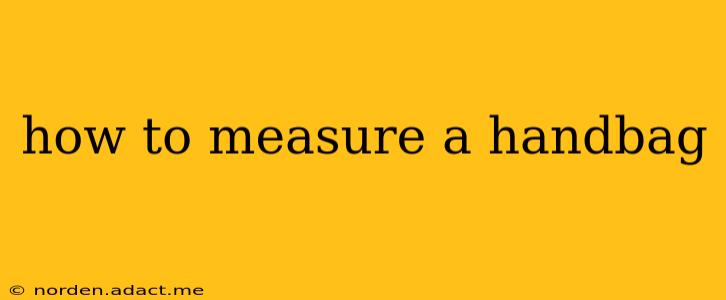Choosing the perfect handbag can be tricky. Knowing its exact dimensions is crucial, ensuring it fits your needs and style. Whether you're buying online, selling a pre-loved bag, or simply want to organize your closet, knowing how to accurately measure a handbag is an essential skill. This guide will walk you through the process, covering everything from the necessary tools to understanding the measurements themselves.
What Tools Do I Need to Measure a Handbag?
Before you begin, gather the following simple tools:
- A flexible tape measure: This is essential for accurately measuring curved surfaces. A fabric tape measure is ideal as it conforms easily to the bag's shape.
- A ruler or straight edge (optional): Useful for double-checking measurements, particularly for straight edges like the base of the bag.
- Pen and paper: To record your measurements.
How to Measure the Key Dimensions of a Handbag
To get a complete picture of a handbag's size, we need to measure several key dimensions. Let's break down each measurement:
1. Height
Measure the handbag's height from the bottom of the bag to the highest point, usually the top of the handle. If the bag has a structured top, measure to the top edge. For bags with a slouchy or soft design, measure the highest point while the bag is resting naturally.
2. Width
Measure the widest part of the handbag's base. Lay the bag flat and measure across the bottom, from edge to edge. This measurement helps determine how much the bag can hold.
3. Depth
Measure the depth of the handbag at its widest point. This is the measurement from the front to the back of the bag, usually at the base. This dimension gives an idea of how many items you can fit inside and how bulky the bag will be.
4. Handle Drop (if applicable)
If the handbag has handles, measure the handle drop. This is the vertical distance from the top of the bag to the bottom of the handle. This measurement helps you determine if the bag will fit comfortably on your shoulder or arm.
5. Strap Length (if applicable)
If the handbag has a strap (shoulder strap, crossbody strap), measure its length from end to end. You can also specify the different measurements for the adjusted drop lengths of the strap, i.e., how long the strap is from the top of the bag when worn across the body, or on the shoulder.
6. Base Measurements (Optional but Helpful)
For a more precise measurement, consider measuring the length and width of the bag's base separately. This can be especially helpful when comparing similar bags or if the bag has a unique shape.
What are the standard handbag sizes?
Handbag sizes can vary greatly depending on the style and designer. There isn't a universally agreed upon sizing chart. However, you can generally categorize handbags as:
- Small: Typically suitable for essentials like your phone, wallet, and keys.
- Medium: A versatile size that can accommodate more items.
- Large: Great for carrying laptops, books, and other larger items.
- Oversized: Extra-large bags, often used as travel bags or totes.
How to Measure a Handbag with Irregular Shapes?
Some handbags have unusual shapes, making precise measurements more challenging. In these cases, focus on the key dimensions mentioned above and try to be as accurate as possible. You might need to take multiple measurements to capture the bag’s unique form. You can also use descriptive words in addition to your measurements, e.g. "slightly curved" or "rounded base".
Why is Measuring a Handbag Important?
Accurate measurements are vital for several reasons:
- Online Shopping: Avoid disappointment by ensuring the bag's size aligns with your expectations.
- Selling Handbags: Providing accurate measurements increases the likelihood of a sale.
- Organizing Your Closet: Precise measurements help you easily identify and organize similar bags.
- Comparing Handbags: Measuring different bags allows you to compare sizes effectively.
By following these steps, you can confidently measure your handbags and make informed decisions about your purchases and organization. Remember, accuracy is key!
